
Malvaceae, or the mallows, is a family of flowering plants estimated to contain 244 genera with 4225 known species. Well-known members of economic importance include okra, cotton, cacao and durian. There are also some genera containing familiar ornamentals, such as Alcea (hollyhock), Malva (mallow) and Lavatera, as well as Tilia. The largest genera in terms of number of species include Hibiscus, Sterculia, Dombeya, Pavonia and Sida.

Thespesia is a genus of 13 flowering shrubs and trees in the Hibiscus family, Malvaceae, although within the family they are more closely related to cotton plants (Gossypium). The genus is distributed from the South Pacific through Asia, Africa, and the Caribbean.
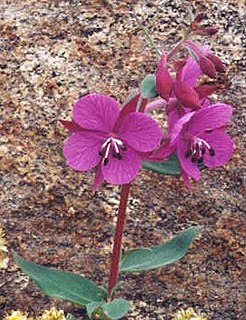
The Onagraceae are a family of flowering plants known as the willowherb family or evening primrose family. They include about 650 species of herbs, shrubs, and trees in 17 genera. The family is widespread, occurring on every continent from boreal to tropical regions.

Nyctaginaceae, the four o'clock family, is a family of around 33 genera and 290 species of flowering plants, widely distributed in tropical and subtropical regions, with a few representatives in temperate regions. The family has a unique fruit type, called an "anthocarp", and many genera have extremely large pollen grains.
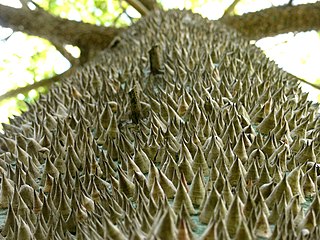
Bombacoideae is a subfamily of the mallow family, Malvaceae. It contains herbaceous and woody plants. Their leaves are alternate, commonly palmately lobed, with small and caducous stipules. Flowers are hermaphroditic and actinomorphic; the calyx has 5 sepals united at the base, "NOT" accompanied by an epicalyx (involucel). The corolla has 5 free petals and an androecium of numerous stamens, typically with free filaments "NOT" fused in a staminal tube (column). The pollen is smooth and the ovary superior and pluricarpellate. Fruits are schizocarpous or capsular.
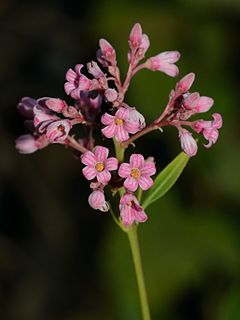
Apocynoideae is a subfamily of the flowering plant family Apocynaceae. It contains about 78 genera with roughly 860 species. Several genera are of pharmacological interest - notably those - such as Strophanthus - which have furnished highly effective arrow poisons, due to their cardiac glycoside content. The subfamily includes many species with flowers of considerable ornamental value, the best-known of which is Nerium oleander, the familiar Oleander. It also contains the remarkable pachycaul genera Adenium and Pachypodium.
Durio rosayroana is a species of flowering plant in the family Malvaceae. It is endemic to Sri Lanka.

Lasiopetalum, commonly known as velvet bushes, is a genus of about forty-five species of flowering plants in the family Malvaceae, all endemic to Australia.
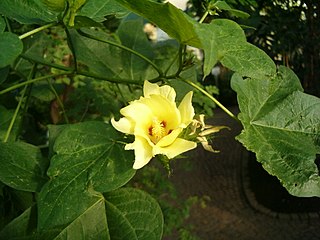
Gossypieae is a tribe of the flowering plant subfamily Malvoideae. It includes the cotton (Gossypium) and related plants. It is distinguished from the Hibisceae on the basis of embryo structure and its apparently unique possession of glands able to synthesize the pigment gossypol.

Helicteroideae is a subfamily of the family Malvaceae. Some taxonomists place genera in Helicteroideae in distinct families Durionaceae and Helicteraceae, while others recognizes the tribes Durioneae and Helictereae.

Sterculioideae is a subfamily of the family Malvaceae containing evergreen and deciduous trees and shrubs.

Hibisceae is a tribe of flowering plants in the mallow family Malvaceae, subfamily Malvoideae.
Radyera is a genus of flowering plants in the family Malvaceae.

Malvaviscus arboreus is a species of flowering plant in the hibiscus family, Malvaceae, that is native to the Southeastern United States, Mexico, Central America, and South America. The specific name, arboreus, refers to the tree-like appearance of a mature plant. It is now popular in cultivation and goes by many English names including Turkcap, Turk's turban, wax mallow, ladies teardrop and Scotchman's purse. Its flowers do not open fully and help attract butterflies and hummingbirds.

Malveae is a tribe of flowering plants in the mallow family Malvaceae, subfamily Malvoideae. The tribe circumscribes approximately 70 genera and 1040 species and has the greatest species diversity out the three tribes that make up Malvoideae. The flowers of Malveae are five-merous with a characteristic staminal column, a trait found throughout Malvoideae. Although there are not many economically important species within Malveae, the tribe includes Althaea officinalis, otherwise known as the Marsh Mallow.
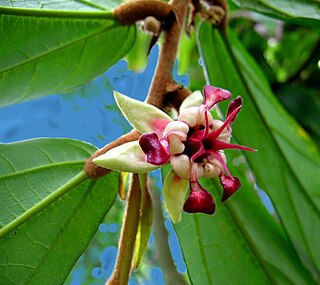
Byttnerioideae is a subfamily of the flowering plant family Malvaceae.

Phymosia umbellata is a species of flowering plant in the family Malvaceae. It is native to Mexico and is cultivated as an ornamental plant.

Seringia velutina is a shrub in the Malvaceae family native to Western Australia.
Maxwellia lepidota is a species of shrubs or trees in the family Malvaceae. It is endemic to New Caledonia and the only species of the genus Maxwellia. Its closest relatives are all Australian genera in tribe Lasiopetaleae: Guichenotia, Hannafordia, Lysiosepalum, Lasiopetalum and Thomasia.
Carolyn F. Wilkins is an Australian botanist, who currently works for the Western Australian Department of Biodiversity, Conservation and Attractions.





















